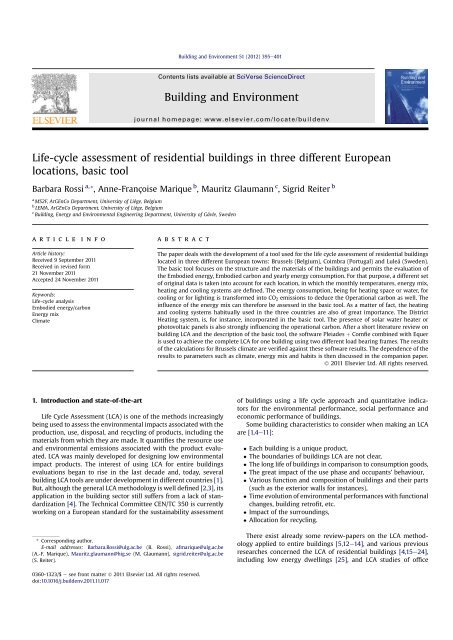Session 1 - Montefiore
Session 1 - Montefiore
Session 1 - Montefiore
Create successful ePaper yourself
Turn your PDF publications into a flip-book with our unique Google optimized e-Paper software.
Life-cycle assessment of residential buildings in three different European<br />
locations, basic tool<br />
Barbara Rossi a, *, Anne-Françoise Marique b , Mauritz Glaumann c , Sigrid Reiter b<br />
a MS2F, ArGEnCo Department, University of Liège, Belgium<br />
b LEMA, ArGEnCo Department, University of Liège, Belgium<br />
c Building, Energy and Environmental Engineering Department, University of Gävle, Sweden<br />
article info<br />
Article history:<br />
Received 9 September 2011<br />
Received in revised form<br />
21 November 2011<br />
Accepted 24 November 2011<br />
Keywords:<br />
Life-cycle analysis<br />
Embodied energy/carbon<br />
Energy mix<br />
Climate<br />
1. Introduction and state-of-the-art<br />
abstract<br />
Life Cycle Assessment (LCA) is one of the methods increasingly<br />
being used to assess the environmental impacts associated with the<br />
production, use, disposal, and recycling of products, including the<br />
materials from which they are made. It quantifies the resource use<br />
and environmental emissions associated with the product evaluated.<br />
LCA was mainly developed for designing low environmental<br />
impact products. The interest of using LCA for entire buildings<br />
evaluations began to rise in the last decade and, today, several<br />
building LCA tools are under development in different countries [1].<br />
But, although the general LCA methodology is well defined [2,3], its<br />
application in the building sector still suffers from a lack of standardization<br />
[4]. The Technical Committee CEN/TC 350 is currently<br />
working on a European standard for the sustainability assessment<br />
* Corresponding author.<br />
E-mail addresses: Barbara.Rossi@ulg.ac.be (B. Rossi), afmarique@ulg.ac.be<br />
(A.-F. Marique), Mauritz.glaumann@hig.se (M. Glaumann), sigrid.reiter@ulg.ac.be<br />
(S. Reiter).<br />
0360-1323/$ e see front matter Ó 2011 Elsevier Ltd. All rights reserved.<br />
doi:10.1016/j.buildenv.2011.11.017<br />
Building and Environment 51 (2012) 395e401<br />
Contents lists available at SciVerse ScienceDirect<br />
Building and Environment<br />
journal homepage: www.elsevier.com/locate/buildenv<br />
The paper deals with the development of a tool used for the life cycle assessment of residential buildings<br />
located in three different European towns: Brussels (Belgium), Coimbra (Portugal) and Luleå (Sweden).<br />
The basic tool focuses on the structure and the materials of the buildings and permits the evaluation of<br />
the Embodied energy, Embodied carbon and yearly energy consumption. For that purpose, a different set<br />
of original data is taken into account for each location, in which the monthly temperatures, energy mix,<br />
heating and cooling systems are defined. The energy consumption, being for heating space or water, for<br />
cooling or for lighting is transformed into CO2 emissions to deduce the Operational carbon as well. The<br />
influence of the energy mix can therefore be assessed in the basic tool. As a matter of fact, the heating<br />
and cooling systems habitually used in the three countries are also of great importance. The District<br />
Heating system, is, for instance, incorporated in the basic tool. The presence of solar water heater or<br />
photovoltaic panels is also strongly influencing the operational carbon. After a short literature review on<br />
building LCA and the description of the basic tool, the software Pleiades þ Comfie combined with Equer<br />
is used to achieve the complete LCA for one building using two different load bearing frames. The results<br />
of the calculations for Brussels climate are verified against these software results. The dependence of the<br />
results to parameters such as climate, energy mix and habits is then discussed in the companion paper.<br />
Ó 2011 Elsevier Ltd. All rights reserved.<br />
of buildings using a life cycle approach and quantitative indicators<br />
for the environmental performance, social performance and<br />
economic performance of buildings.<br />
Some building characteristics to consider when making an LCA<br />
are [1,4e11]:<br />
Each building is a unique product,<br />
The boundaries of buildings LCA are not clear,<br />
The long life of buildings in comparison to consumption goods,<br />
The great impact of the use phase and occupants’ behaviour,<br />
Various function and composition of buildings and their parts<br />
(such as the exterior walls for instances),<br />
Time evolution of environmental performances with functional<br />
changes, building retrofit, etc.<br />
Impact of the surroundings,<br />
Allocation for recycling.<br />
There exist already some review-papers on the LCA methodology<br />
applied to entire buildings [5,12e14], and various previous<br />
researches concerned the LCA of residential buildings [4,15e24],<br />
including low energy dwellings [25], and LCA studies of office











